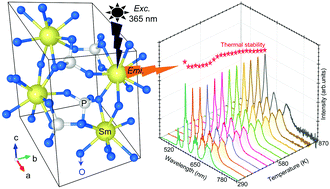Non-quenching photoluminescence emission up to at least 865 K upon near-UV excitation in a single crystal of orange-red emitting SmPO4†
Abstract
The adjustment of photoluminescence emission spectrum and an enhancement in the thermal stability of red/orange-red emitting phosphors is an important issue for the whole lighting industry. Herein, we present our results on the luminescence spectroscopy of a single crystal sample of SmPO4 exhibiting a prominent orange-red emission at 597 nm, along with a charge-transfer absorption (O2− → Sm3+) around 200 nm. We study the temperature dependence of emission spectra in SmPO4 for excitations at 365 and 455 nm, to mimic experimental conditions for phosphor converted light emitting diodes, to show that the sample has a non-quenching photoluminescence emission up to at least 865 K for an excitation at 365 nm, and ∼865 K for an excitation at wavelength, 455 nm. The thermal stability of SmPO4 was found to be much higher than its structural analogue, EuPO4, which is also an orange-red emission phosphor, but possesses a thermal quenching temperature of 710 K (exc. 365 nm), and 735 K (exc. 455 nm). The extraordinary thermal stability of SmPO4 is a result of the energy transfer from deep defects to the Sm3+ ions at high temperatures. The color purity of SmPO4 (65%) was found to be slightly lower than the EuPO4 sample (70%), at room temperature. The results suggests that the rare earth orthophosphate, SmPO4, has a large potential for near-UV excited phosphor converted solid state lighting devices.

- This article is part of the themed collection: 2019 PCCP HOT Articles


 Please wait while we load your content...
Please wait while we load your content...